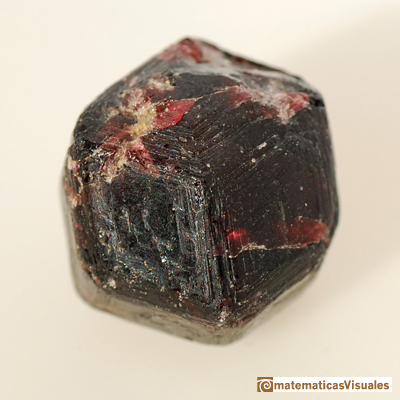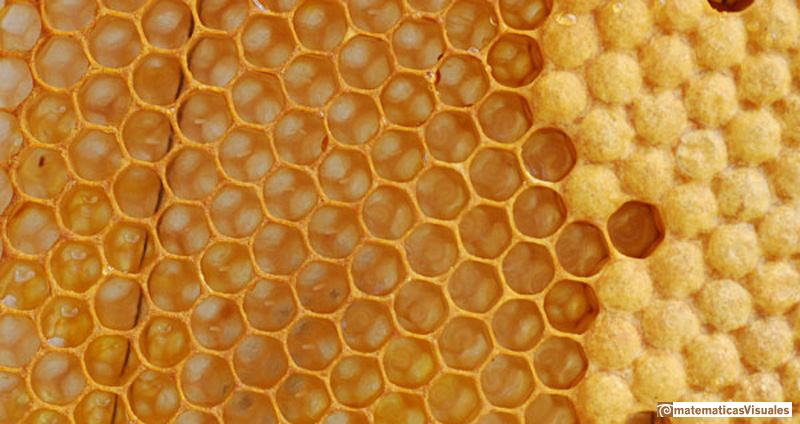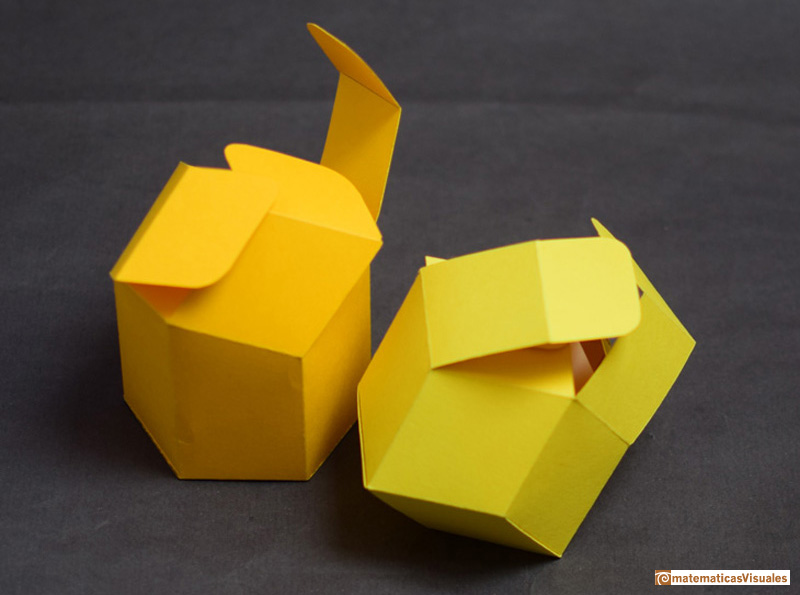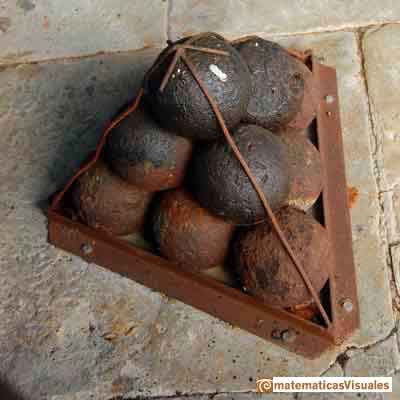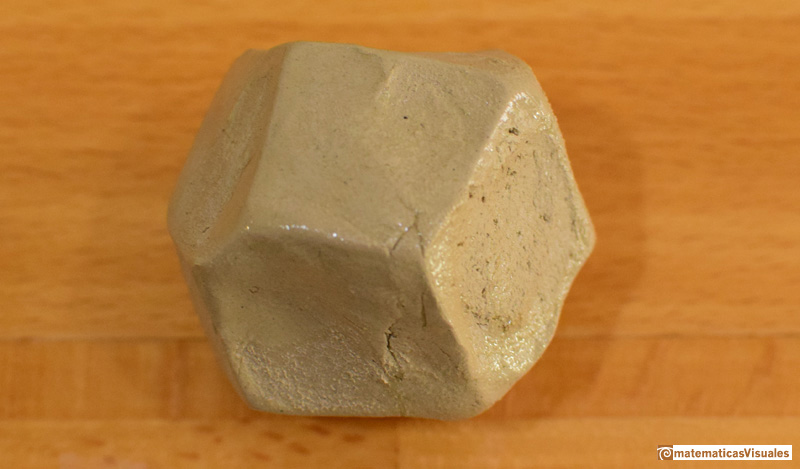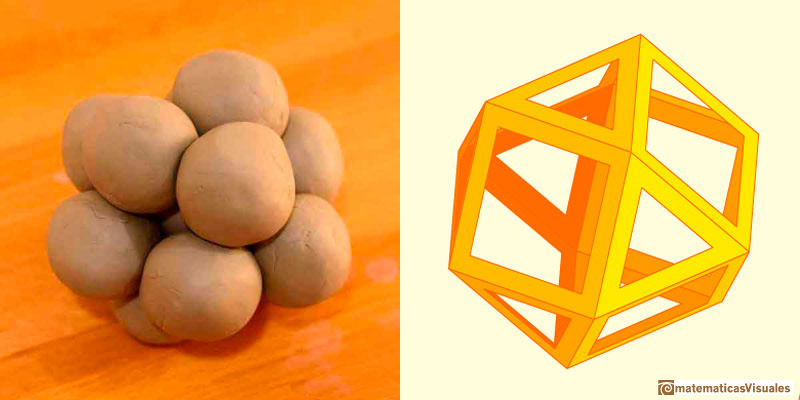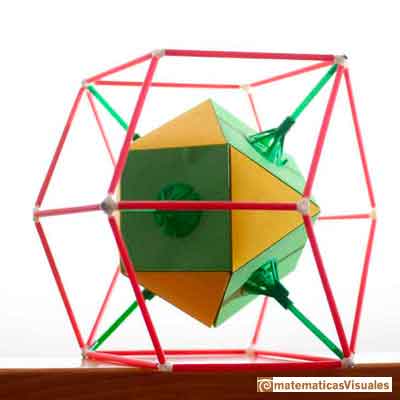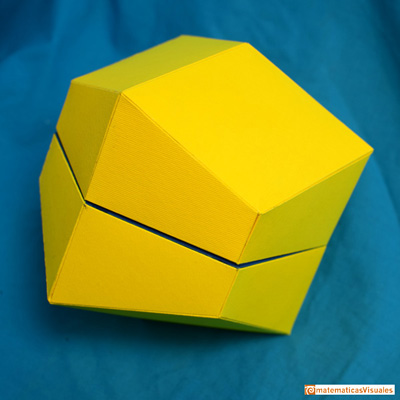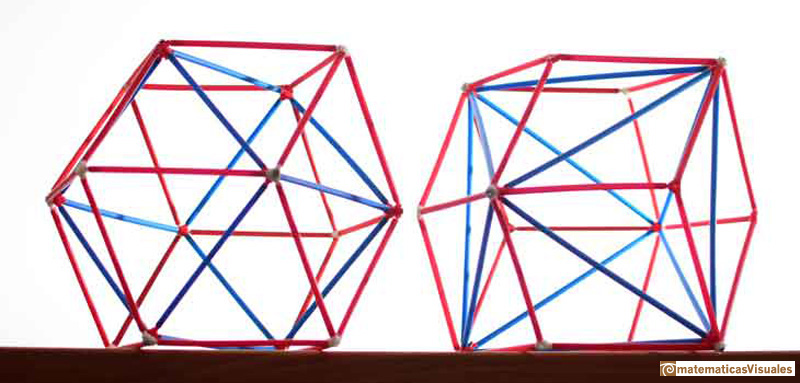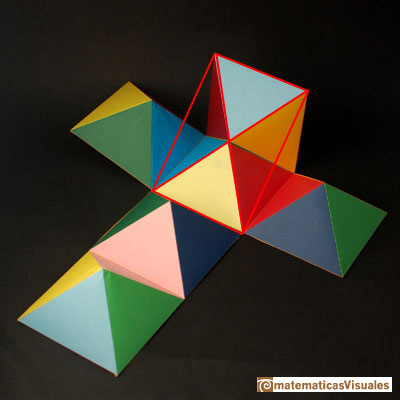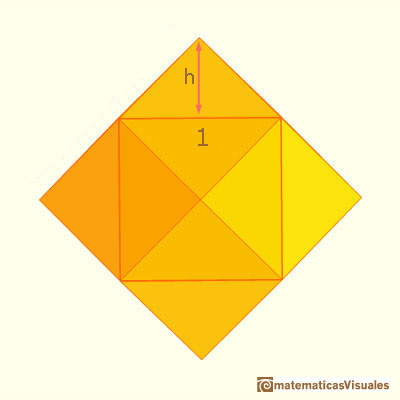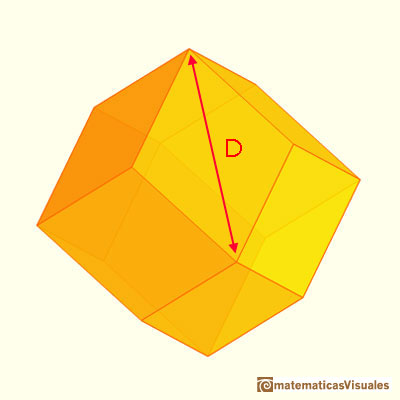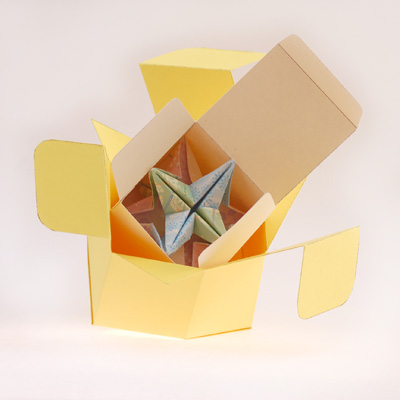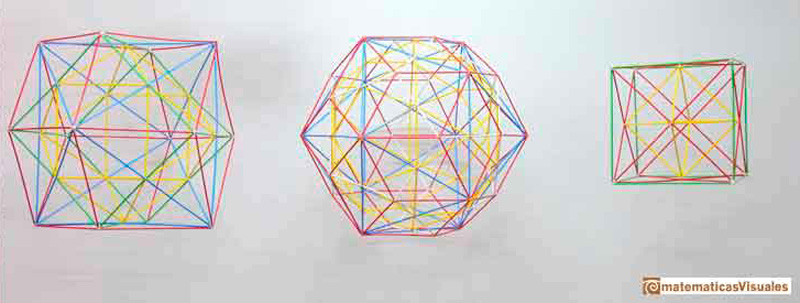Kepler and the Rhombic Dodecahedron
The rhombic dodecahedron is a simple and beautiful polyhedron. It is also easy to place within an historical context since we know its discoverer: German astronomer and mathematician Johannes Kepler (1571–1630). On at least three different occasions, Kepler wrote about this polyhedron, showing readers complementary approaches to understanding it. He saw it at the bottom of bee cells. He examined its relation to the difficult problem of the best way of packing spheres (the Kepler Conjecture). And, he was aware that it shares with the cube the property of tessellating space.
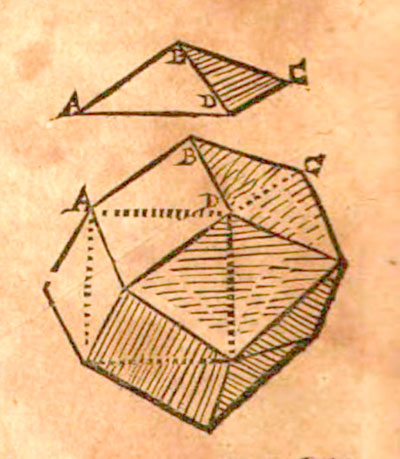
Figure 1. Drawing of a rhombic dodecahedron from Kepler's book
Epitome astronomiae copernicanae [Kepler 1618–1621, ii:461].
The rhombic dodecahedron is thus related to the observation of nature, as well as to certain technical and mathematical questions that are both difficult and fruitful. It is even associated with art—Renaissance artists studying polyhedra nearly discovered the rhombic dodecahedron prior to Kepler’s investigations.
In this article, I explore these different historical ways of making sense of this polyhedron and offer readers (teachers, in particular) student-tested resources that can be used to highlight the beauty of mathematics. These materials range in level of difficulty, from building models of basic polyhedra to carrying out some basic calculations to using derivatives to solve a more challenging optimization problem. The activities can therefore be adapted for use with a variety of student audiences in the classroom or in workshops.
I have found that the interdisciplinary approach of these materials provides an enriching way to study mathematics that appeals to today’s students. In this age of electronic devices that offer powerful opportunities for communicating and modeling mathematical concepts, perhaps we should at the same time not lose sight of the educational value in manual activities such as constructing polyhedra. Certainly, my experience is that students enjoy this kind of hands-on activity and we all appreciate the aesthetic appeal of the finished products.
But there are even more potential benefits. For example, physically manipulating three-dimensional bodies gives us a better understanding of the mathematical properties of these objects. Students discover that mathematics is all around them and they are able to understand how it works. Finally, as students recreate the various directions that Kepler’s thinking followed, they realize that mathematics is not a fixed body of knowledge but rather has always been a science in progress. Please continue reading to join me on the voyage of mathematical appreciation that the rhombic dodecahedron makes possible.
Kepler and the Rhombic Dodecahedron: Article Objectives
The principal goal of this article is to share materials and activities designed to engage students in the study of mathematics (namely, of polyhedra) within an historical context. It focuses on the rhombic dodecahedron—a simple, beautiful and interesting polyhedron that can delight young and old alike. In our journey of exploring its properties, we follow paths traced by the wonderful mind of its discoverer: Johannes Kepler (1571–1630).
Although we do not know how Kepler first conceived of the rhombic dodecahedron, he wrote about it in at least three books: Strena Seu De Nive Sexangula [The Six-Cornered Snowflake. A New Year Gift, 1611], Epitome Astronomiae Copernicanae [Epitome of Copernican Astronomy, 1618–1621], and Harmonices Mundi [The Harmony of the World, 1619]. The activities that I share in this article relate Kepler’s thinking in these works with three interdisciplinary points of view that connect mathematics with other aspects of human activity:
- Nature, based on Kepler’s fascinating look into how bees build the cells of their honeycombs.
- Technology, based on Kepler’s exploration of the problem of finding the optimal way to pack cannonballs, in which he astonishingly imagined squeezing them, a thought experiment that led him to the proposal that is now called the ‘Kepler Conjecture’.
- Art, based on Kepler’s view of the rhombic dodecahedron as a cube topped with pyramids, a view that Renaissance mathematicians and artists like Leonardo da Vinci were very close to discovering before Kepler did.
I have used these materials with students several times, and the experience is always a success. Both the beauty of polyhedra and the interdisciplinary approach of the activities help to engage students in the study of mathematics.
It is also enriching for our students to become aware that mathematics is not a finished science. On the contrary, it is a subject in continual development. The tale of Kepler’s discovery of the rhombic dodecahedron places us in a wonderful position to see this. Indeed, after his remarkable achievements with the rhombic dodecahedron, Kepler’s mind did not rest; he discovered a second rhombic polyhedron (now called the triacontahedron), and he was aware that the cube was a third rhombic polyhedron.
To follow these ideas is not easy without concrete mathematical models. A second objective of this article is thus to encourage readers and their students to build and play with their own polyhedra. As previously noted, modeling polyhedra is not only an enjoyable activity in itself with results that are appealing for their beauty; we also learn about the mathematical properties of these bodies when we make, examine, and touch them.
On the following pages, teachers and their students will find background historical information and classroom-tested resources (including several video animations) that offer guidance in building these models, exploring the mathematics that they embody, and placing the ideas that emerge within a historical context that unveils sociocultural settings for mathematics.
Kepler and the Rhombic Dodecahedron: Overview of Article Structure and Its Use with Students
The materials and activities that we present in this article have been tested in the classroom and in workshops with students in the 11–16 year age group. Both the text and the accompanying activities that follow are adapted to this target audience. Teachers of these and other age groups can use the article text as a basic (written or spoken) script for implementing these activities in their classroom, or they may adapt the associated materials as appropriate for use with their students.
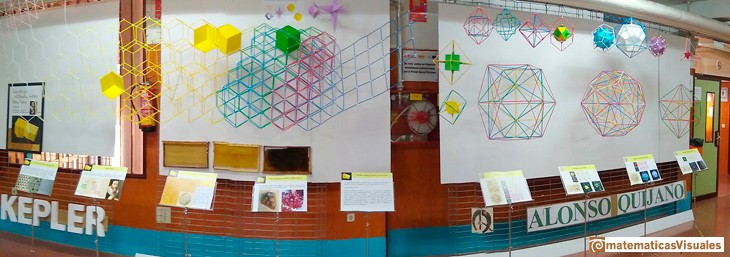
Figure 2. Panoramic of the exhibition ‘Kepler, honeybees, and the rhombic dodecahedron’
(Alcalá de Henares, Spain, 2020).
The next four sections form the core of this article, as they provide the basis for a classroom project or student workshop session of length 90–120 minutes:
- Introducing the Rhombic Dodecahedron
- Kepler and His Time
- Honeycombs and the Discovery of the Rhombic Dodecahedron
- Building a Rhombic Dodecahedron
After a short presentation of the rhombic dodecahedron, we talk about its discoverer, Johannes Kepler, and the historical context in which he worked. The description of how bees build their cells that comes next is always fascinating to students and exposes some interesting properties of this polyhedron. Following that introduction, students can construct a paperboard rhombic dodecahedron as well as a model of a bee cell. Each student will then have their own beautiful polyhedron that can serve to remind them of some of its properties. Building polyhedra using simple templates is the objective of this activity.
I can report from my own experience that a workshop based on the material presented in these four sections is always a success with young students. Honeybees are inherently appealing, and the models are simple, beautiful, interesting—and easy to build. An effective option for finishing this session is to glue all of the students’ rhombic dodecahedra together in order to demonstrate how this polyhedron tessellates space.
The subsequent two sections of the article focus on activities related to the technical problem of how best to pack cannonballs. These activities provide the basis for a second component of an extended classroom project or an additional workshop session of length 90 minutes:
When Kepler studied the optimal packing of spheres, he found that the rhombic dodecahedron can be generated by compressing thirteen cannonballs together. It is very easy to reproduce this experiment using clay balls, and the result astonishes the audience. After this experiment, we are in a wonderful position to talk about another beautiful polyhedron that interested Kepler: the cuboctahedron. The dual relationship between these two polyhedra can also be demonstrated with physical models.
The final three sections of the article then take up the art theme and provide the basis for a third component for a classroom project or an additional workshop session of length 90 minutes:
- Renaissance Artists – They Almost Got It!
- The Rhombic Dodecahedron as a Cube with Pyramids
- Building a Cube and an Octahedron Inside a Rhombic Dodecahedron
The story of the explosion of interest in polyhedra that occurred after the 15th century is a good opportunity to mix history, art, and geometry. (See Cromwell's Polyhedra [1997] and Pedoe's Geometry and the Liberal Arts [1978].) Kepler’s insight that the rhombic dodecahedron can be viewed as a cube topped with pyramids allows students to learn interesting geometric properties of this polyhedron, such as the measures of its diagonals, edges, angles, and volume. Since the prerequisites for these various computations range from elementary plane geometry (including the Pythagorean Theorem) to basic trigonometry, the technical details can be presented simply by the instructor or explored in more depth by those students who have the necessary mathematical background.
Kepler and the Rhombic Dodecahedron: Introducing the Rhombic Dodecahedron
We now begin our study of the rhombic dodecahedron. This polyhedron is related to some deep questions in mathematics (for example, the Kepler Conjecture that is briefly presented later) as well as to other fields of science such as crystallography and chemistry. Yet, it is also a simple and beautiful polyhedron with a wonderful history that will engage anyone interested in mathematics and polyhedra.
The word polyhedron (plural polyhedra) comes from Greek and literally means “many faces.” In geometry, a polyhedron is any three-dimensional shape that has flat polygonal faces—which need not all be the same. The rhombic dodecahedron is a polyhedron with twelve equal faces that are rhombi.
The rhombic dodecahedron.
This polyhedron was discovered by the German astronomer and mathematician Johannes Kepler around 1600.
It is remarkable that there is no evidence that anyone before Kepler wrote about it. We can be sure that the shape of the rhombic dodecahedron was well known: a mineral called a garnet has been used since prehistoric times as a gemstone. It is beautiful, abundant, and cheap.
Figure 3. Garnet with the shape of a rhombic dodecahedron.
Nonetheless, it seems that mathematicians were not interested in this shape until Kepler. The most plausible reason for this may be that this polyhedron is not regular in the sense that interested Greek mathematicians. Its faces are rhombi, not regular polygons (that is, polygons that have equal sides symmetrically placed about a common center, such as an equilateral triangle), and it does not have only one kind of vertex—rather, some of its vertices have degree 3 and others have degree 4 (unlike the Platonic and Archimedean solids that we talk about later in this article).
The next section begins by looking at some basic facts about Kepler's life and times to put his discovery in an historical context. Following the topics discussed in Kepler’s publications, we then will study the rhombic dodecahedron from three different points of view: nature, technology, and art. Each theme will reveal some complementary properties of this polyhedron. Throughout this exploration of Kepler’s discovery, we will also see how mathematics itself is a subject that is continually being developed, with the creation of new mathematics continuing even today. For example, in the concluding section of this article, we will observe a few of the questions that Kepler asked about polyhedra which spurred additional discoveries in this field.
Kepler and the Rhombic Dodecahedron: Kepler and His Time
Johannes Kepler (1571–1630) was a German scientist, mathematician, astronomer, and astrologer. He lived in a time full of new ideas and discoveries.
The timeline below gives a sense of the historical context of his time in relation to the cultural Renaissance (or “Rebirth”) that came just before it and the important mathematical period (in which calculus was discovered by Newton and Leibniz) that followed.
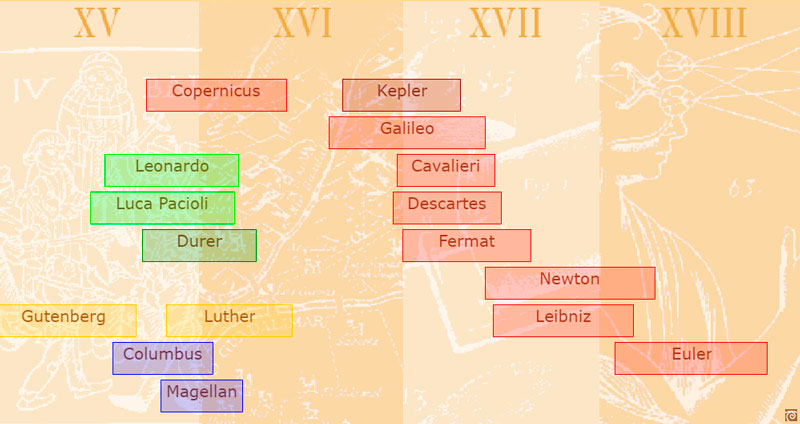
Figure 4. Basic timeline of the historical context of Kepler’s time, showing Kepler was a man who lived and worked between the Renaissance and the great mathematical discoveries of Newton and Leibniz. The names shown in red are those of important mathematicians and scientists, and those in green are famous artists (although Dürer is also remembered as a mathematician).
The Renaissance that preceded Kepler’s time was a period in European history that is often seen as a transition between the medieval era and modernity. More people had access to old and new ideas, thanks to the invention of the printing press by Johannes Gutenberg (ca 1400–1468) and the slow expansion of literacy that followed. Artists developed new techniques, such as the use of linear perspective, that in part encouraged the creation of more realistic representations of the natural world. It was also a time of significant religious changes, most notably the Protestant Reformation instigated by the actions of Martin Luther (1483–1546), and the European exploration of the world was underway.
One of the most important new scientific ideas of the Renaissance was the sun-centered (or heliocentric) cosmology, which posited that the Earth and all planets revolve around the Sun, posited by Nicolaus Copernicus (1473–1543). The 1543 publication of Copernicus’ book De Revolutionibus orbium coelestium (On the revolution of the heavenly spheres) started what has been called the Copernican Revolution, as the astronomical theory that it described challenged the long-held assertion that the Earth was the stationary center of the universe. Copernicus’ ideas influenced both the work of Kepler, who from his youth was an early supporter of the heliocentric model, and the thinking of Kepler’s famous scientific contemporary, Galileo Galilei (1564–1642).
While we might assume that this “revolution” led to the abandonment of earlier understandings of mathematics and science, in fact the late 16th and early 17th centuries were an age in which the Greek mathematical masterworks—such as the Elements of Euclid (ca 325–ca 265 BCE), the Conics of Apollonius (ca 240–ca 190 BCE), and the works of Archimedes (ca 287–ca 212 BCE)—were also studied seriously. Geometry interested not only mathematicians and scientists, but also artists and craftsmen.
It was into this fertile period for mathematics that Johannes Kepler was born in Weil der Stadt (now in southwest Germany) in 1571. His parents were poor. He was an intelligent boy whose health was delicate. Throughout his life, his place of residence changed several times. Before he was 30, he studied at the University of Tübingen; was appointed as a mathematics teacher in Graz; and briefly worked with the famous astronomer Tycho Brahe (1546–1601) in Prague. Kepler remained in Prague, serving as Imperial Mathematician, for 11 years following Brahe’s death. Due in part to growing political-religious tension, Kepler then moved first to Linz (where he lived from 1612 to 1626) and later to Ulm and the Silesian town of Sagan (Żagań). He died after a short illness while visiting Regensburg in 1630.
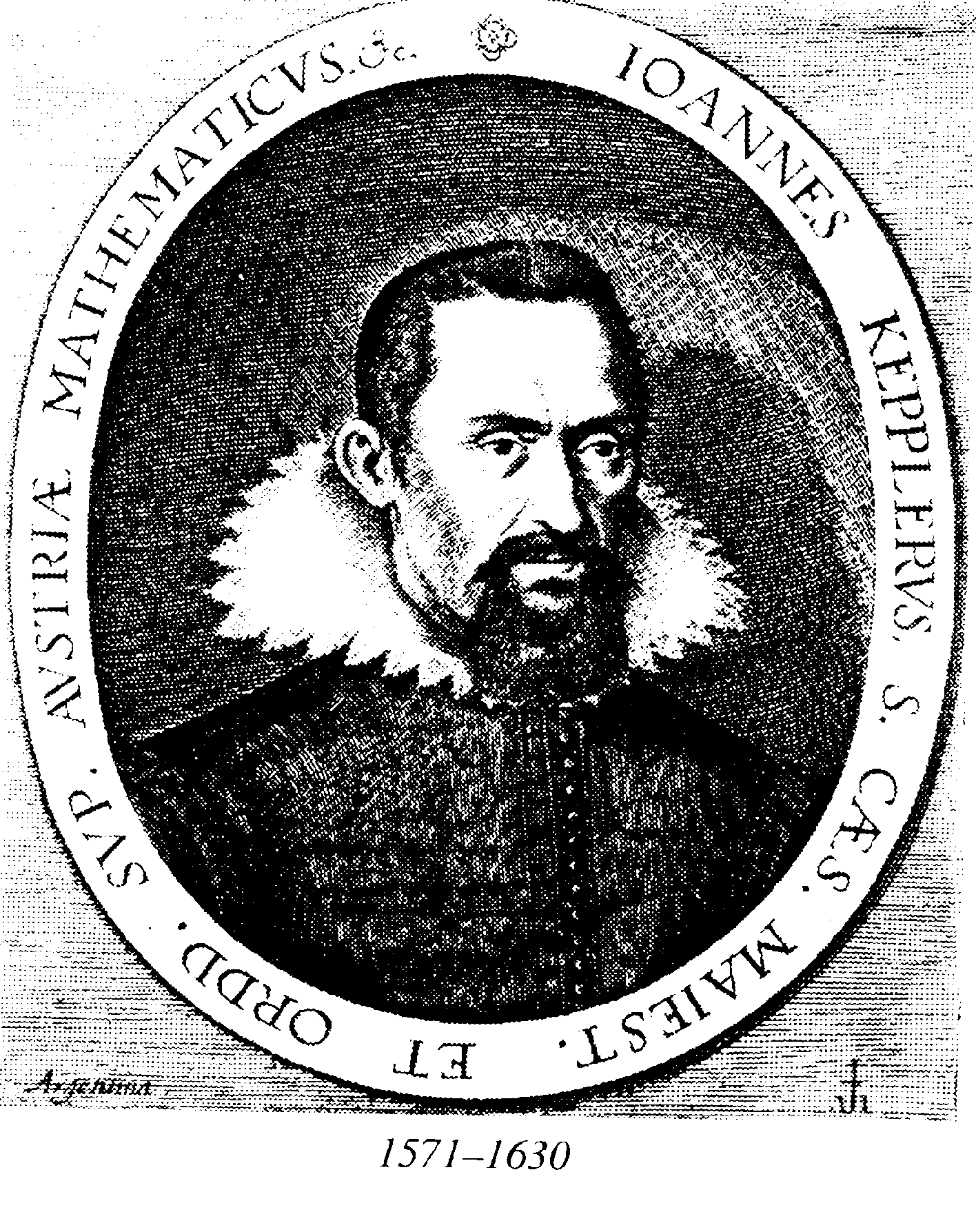
Figure 5. Portrait of Kepler (MAA Convergence Portrait Gallery).
Kepler’s life was not easy, and he lived during troubled political times. He struggled with bad health, financial troubles, and family difficulties (for example, his mother was imprisoned for a time on charges of witchcraft). He was also affected by religious conflicts (a deeply religious man, Kepler left his teaching post at Graz due to the Catholic Counter-Reformation) and even war (the religious strife of the Thirty Years’ War that devastated Germany broke out in 1618).
Despite these circumstances, Kepler was able to make important contributions to science, in particular to astronomy, optics, and mathematics.
As an astronomer, Kepler is famous for his discovery of the three laws of planetary motion now known as Kepler’s Laws. Newton later showed that these could be deduced from Newton's laws of motion and the universal law of gravitation. His work on optics included conclusions about the intensity of light based on Tycho’s observations of eclipses as well as improvements to the refracting telescope.
As a mathematician, Kepler discovered two new regular polyhedra (today called the great and small stellated dodecahedron) and two new rhombic polyhedra (the rhombic dodecahedron and the triacontahedron), worked on the problem of close packing of equal spheres, was interested in logarithms, and found volumes of solids of revolution using methods that were precursors to the important calculus discoveries made by Newton and Leibniz.
Kepler enjoyed a fertile imagination. As an example, we can consider how a life event led him to think about the volume of solids. When he married for the second time, Kepler was surprised by the wine merchant’s technique for measuring the volume of wine barrels. As a result, Kepler studied how to calculate the volume of solids of revolution.
|
TO INVESTIGATE Kepler: The Volume of a Wine Barrel. To learn more about Kepler’s contribution to the development of calculus, read this article published in Convergence in 2011. |
A similar anecdote relates to the origin of the book that is our main source for Kepler’s discovery of the rhombic dodecahedron.
The title of this book is Strena Seu De Nive Sexangula [The Six-Cornered Snowflake. A New Year Gift, 1611].[1] It was written as a 1611 New Year’s gift to Kepler’s friend and benefactor Matthew Wacker von Wackenfels (1550–1619). As Kepler described how he came up with the idea behind this gift, he was thinking and walking along Prague’s Charles Bridge one winter day when
Just then, by a happy occurrence, some of the vapor in the air was gathered into snow by the force of the cold, and a few scattered flakes fell on my coat, all six-cornered, with tufted radii. By Hercules! Here was something smaller than a drop, yet endowed with a shape. Here indeed, was a most desirable New Year’s gift for the lover of Nothing, and one worthy as well of a mathematician (who has Nothing, and receives Nothing) since it descends from the sky and bears a likeness to the stars [Kepler 1611, 33].
As Kepler went on to try to explain the reason for the six-angled shape of snow crystals, his rich imagination flew from honeycombs to peas, and from pomegranates to cannonballs. In the midst of these thoughts, he described a new polyhedron: the rhombic dodecahedron.
In the next section of this article, we will explore how Kepler thought about this polyhedron, how he identified it by looking into the bottom of bee cells, and how we can understand its main properties intuitively.
[1] This beautiful book was written in Prague and published in Frankfurt am Main in 1611. Copies of the first edition are very rare. We can enjoy some images from a first edition in Frank Swetz’s Convergence article, “Mathematical Treasure: Kepler and Sphere-packing,” and a link to a fully-digitized version of the copy owned by the University of Toronto appears above.
Kepler and the Rhombic Dodecahedron: Honeycombs and the Rhombic Dodecahedron
Since its origins, humanity has observed nature and been fascinated by the perfection and beauty of honeycombs.
Figure 6. Bee cells with their hexagonal structure.
Pappus of Alexandria[2] (ca 290–ca 350 CE) was interested in this subject from a mathematical point of view. In the preface to Book V of his Mathematical Collection, he considered how bees build their honeycombs and wrote:
First collecting the sweets of the most beautiful flowers which grow on the earth, they make from them, for the reception of the honey, the vessels which we call honeycombs, [with cells] all equal, similar and contiguous to one another, and hexagonal in form. And that they have contrived this by virtue of a certain geometrical forethought we may infer in this way. They could necessarily think that the figures must be such as to be contiguous to one another, that is to say, to have their sides common, in order that no foreign matter could enter the interstices between them and so defile the purity of their produce. Now only three rectilinear figures would satisfy the condition, I mean regular figures which are equilateral and equiangular; for the bees would have none of the figures which are not uniform. . . . There being then three figures capable by themselves of exactly filling up the space about the same point, the bees by reason of their instinctive wisdom chose for the construction of the honeycomb the figure which has the most angles, because they conceived that it would contain more honey than either of the two others [Heath 1921, 390].
In this paragraph, Pappus dealt with two main ideas. One is the comparison of the areas or volumes of figures of the same perimeter or surface area. Are bees so clever that they expend the least amount of wax in building their honeycombs? This is a type of problem that we call isoperimetric problems. Questions of this kind are usually difficult to answer, but if you know some calculus, you can try the investigation at the bottom of this page.
Pappus’ second idea was more basic. He wrote about what we today call plane tessellations, or the question of how we can fill (or tile) the plane using regular polygons of equal size.
The following images show artistic approaches to plane tessellations. The first is based on equilateral triangles (The Alhambra of Granada); the second has a square grid (The Royal Alcazar of Seville); and the third, based on hexagons, was designed by the architect Antoni Gaudi (1852–1926, Barcelona).

Figure 7. Three artistic examples of plane tessellations. Photos by the author.
This same idea but applied instead to three-dimensional space—that is to say space tessellations—will play an important role in our study of the rhombic dodecahedron. The question will be: how can we fill space using equal polyhedra? Although the problem of finding all such polyhedra is not simple, we have an initial, simple answer: the cube tessellates such a space.
That bees used a hexagonal tessellation to build their honeycombs was a well-known fact. But more than one thousand years after Pappus, Kepler had the wisdom to look at the bottom of the cell!
Honeycomb and the bottom of cells.
We can ascertain how new ideas were born in Kepler’s inventive mind by reading his book De Nive Sexangula [The Six-Cornered Snowflake]. About the structure of the honeycomb, Kepler wrote:
If you should ask the geometers on what plan the cells of bees are built, they will reply, on a hexagonal plan. The answer is clear from a simple look at the openings or entrances, and the sides that form the cells. Each cell is surrounded by six others, and is divided from the next by a shared side. But if you observe the bottom of each cell, you will notice that it slopes into an obtuse angle formed by three planes. This bottom (which you might call the “keel”) is joined to the six sides of the cell by six other angles, three higher ones that are trilateral, just like the bottom angle of the keel, and three lower ones, in between, that are quadrilateral.[3] . . . The three planes of the keel are identical to one another, and their shape is what geometers call a rhombus [Kepler 1611, 37 and 43].
The following drawing is from Kepler's Harmonices Mundi [The Harmony of the World, Linz, 1619], another of his important books. There he drew a polyhedron made of a belt of six rhombi which we can imagine to be placed against the walls of a bee cell. (The walls of actual bee cells are taller than the belt, since the cells themselves are somewhat deeper than they are wide.) Then he added three rhombi “below” in the same way that bees close their cells (the keel), and he closed the “top” of the polyhedron with three more rhombi. (Of course, bees do not close the cell, as they need an open entrance.)
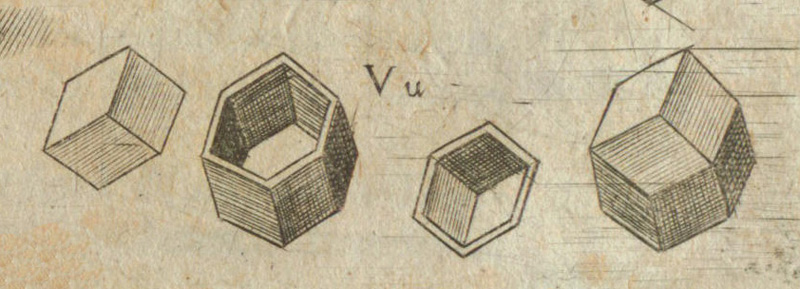
Figure 8. Drawing of a rhombic dodecahedron from Kepler's book Harmonices Mundi. In this drawing, Kepler showed the “top” of the polyhedron to the left of the belt and the keel to its right; the completed polyhedron is the fourth image in Kepler’s drawing.
What properties can we deduce from this depiction of the rhombic dodecahedron?
- The rhombic dodecahedron has 12 rhombic faces, 24 edges. and 14 vertices.
- It has six vertices at which four edges meet (where the angles of the rhombi are acute) and eight vertices at which three edges meet (where the angles of the rhombi are obtuse). Any of the eight vertices at which three edges can be viewed as the bottom tip of the keel, giving us eight “potential keels.”
- The six rhombi attached to one of the possible keels form a belt. These are the rhombi that we imagine are placed along the walls of the bee cell. In fact, the rhombic dodecahedron has four such belts since its eight potential keels can be split into four opposite pairs (with either member of the pair viewed as the actual keel of the polyhedron and the other as its top) that each give rise to a single “shared” belt that joins it together.
- The angle between any two adjacent faces of the six rhombi that form a belt is 120º. It can also be proved using basic trigonometry that the angle between two adjacent faces of the rhombic dodecahedron is 120º. An optional investigation showing why this is the case is shared later in this article.
If we now imagine a layer of bee cells, we can put a rhombic dodecahedron inside each cell.
But Kepler went even further and wrote:
It should also be observed that the cells are arranged in two layers, with the openings facing opposite directions; the backs adjoining one another and closely packed; and the corner of each keel in one layer fitted into the three corners of the three keels in the other. By this workmanship, not only does each cell share six sides with the ones surrounding it in the same layer, but also three planes at the bottom with three other cells from the opposite layer. Thus, each bee has nine neighbors, with each of whom it shares a dividing wall [Kepler 1611, 43].
In other words, underneath our imagined layer of bee cells, each of which contains a rhombic dodecahedron, we can imagine a second layer of bee cells. Then we can imagine that inside this second layer of hexagonal cells, we put another layer of rhombic dodecahedra.
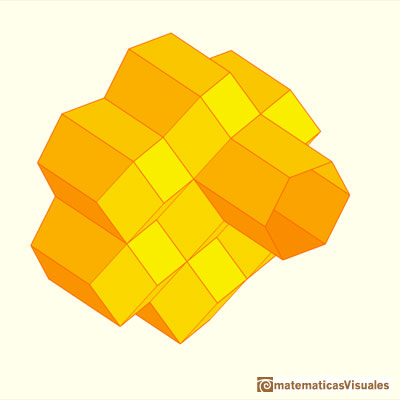
Figure 9. Bee cells in two layers.
Why not add a third and a fourth layer, and so on? In other words, we can imagine infinitely many layers of rhombic dodecahedra. By this simple thought experiment, we can see that this beautiful polyhedron has a surprising property: rhombic dodecahedra tessellate space.
So far, we have seen that Kepler was aware that the way that bees build their cells leads us to a new polyhedron that, like the cube, tessellates space. We will see later in this article that Kepler had an even deeper understanding of the mathematical properties of the rhombic dodecahedron and examine how his creative mind thought about it from points of view other than honeycombs. But before we explore Kepler's other approaches, it will be helpful to our imaginations (and perhaps inspiring!) to build some models of this wonderful polyhedron.
|
TO INVESTIGATE A property of minima in honeycombs. Using derivatives, we can solve an isoperimetric problem that interested 18th-century mathematicians such as Colin Maclaurin (1698–1708): We want to close a hexagonal prism as bees do, using three congruent rhombi. What is the shape of the three such rhombi with minimum total surface area? |
[2] You can read more about Pappus in note 16 by J. Bromberg and G. Bleichmar in [Kepler 1611, 141].
[3] In Kepler's description of the “six other angles” of the keel as “three higher ones that are trilateral” and “three lower ones, in between that are quadrilateral,” it appears that he may have been looking at the bee cell ‘upside down,’ as if the base of the cell was dangling from a string with the vertices at which three faces meet literally higher than the vertices at which four faces meet. This is easier to see by holding an actual physical model of the rhombic dodecahedron.
Kepler and the Rhombic Dodecahedron: Building a Rhombic Dodecahedron
To enjoy this polyhedron, to learn more about it, and to convince ourselves of its beautiful properties, it is highly recommended that readers make an actual rhombic dodecahedron themselves.
Figure 12 provides a template (or net) that can used to build a small paperboard box in the beautiful shape of a rhombic dodecahedron. This template—and a variant of it which produces a box with the shape of a bee cell (Figure 13)—were designed by John Jeremiah Edminster.
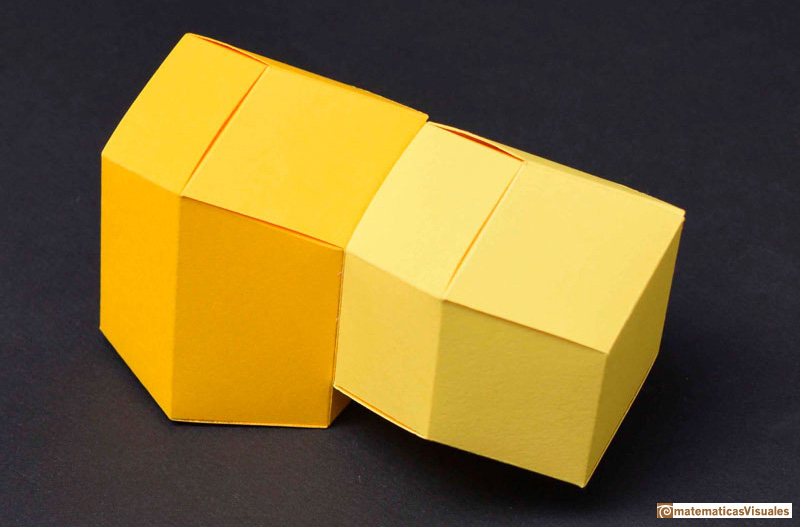
Figure 10. Two completed paperboard models: a bee cell and a rhombic dodecahedron.
Design by John Jeremiah Edminster.
Figure 11. View of the two models as small boxes with open tops.
Design by John Jeremiah Edminster.
To build a model of a rhombic dodecahedron, simply download, print, cut out, and glue together the net shown in Figure 12. (Be sure to cut out all of the triangles, since only the rhombi become faces of the polyhedron.) Looking at this template, we see a horizontal row of six rhombi, the two ends of which should be glued together to make a belt with three rhombi above it and three rhombi below it. To close the polyhedron, bring each set of three rhombi (top and bottom) together with the rounded “tabs” tucked inside.
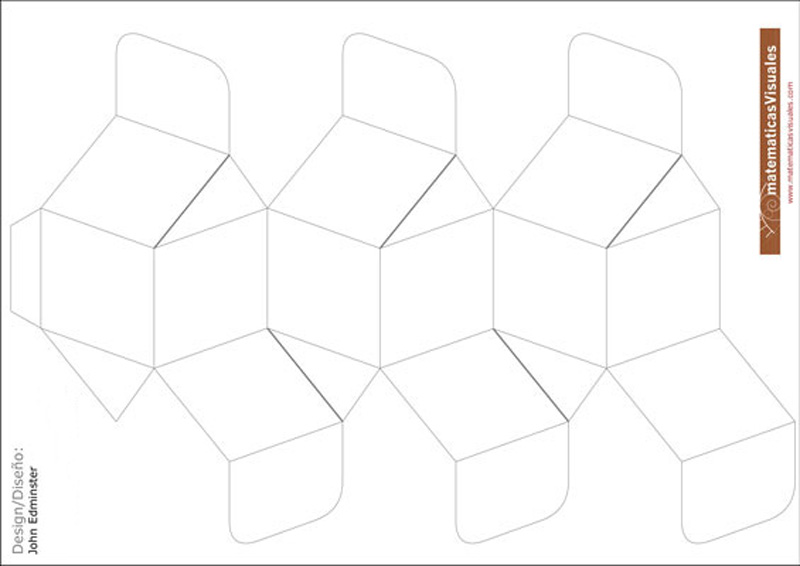
Figure 12. Net of a rhombic dodecahedron. Used by permission
of the designer, John Jeremiah Edminster.
Figure 13 gives a template for the net of a box that is a model of a bee cell. Again, be sure to cut out all the triangles; the polygons in the bottom row of the template (which become the flat top of the box) also need to be cut along their shared edges so that they can be folded separately.
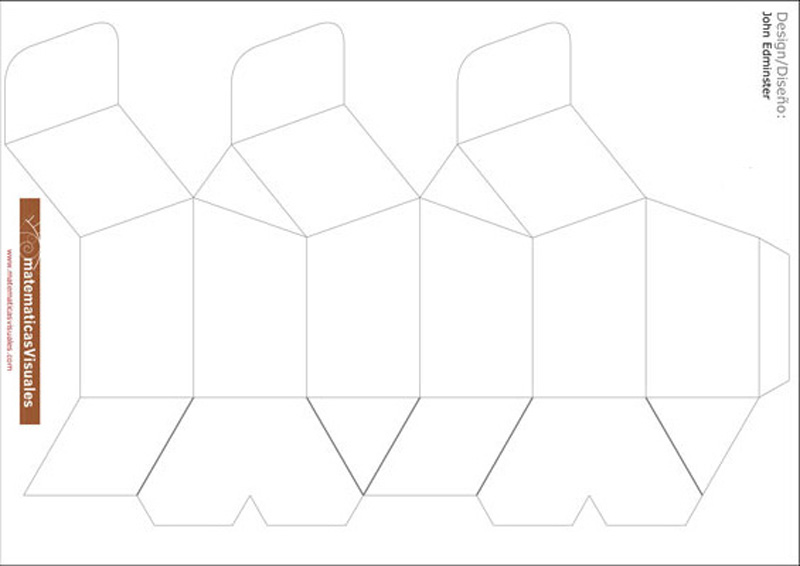
Figure 13. Net of a bee cell. Used by permission of the designer, John Jeremiah Edminster.
If we build several of these polyhedra, we can explore how bees make their honeycombs, as well as investigate the space-tessellation property of the rhombic dodecahedron described in the previous section of this article.
Years after I started building these models with students, it was a pleasure to come across an old article, written in 1936 by W. Hope-Jones in the best tradition in teaching. The title of this inspirational article is “The Rhombic Dodecahedron for the Young”; it is full of good ideas and written with enthusiasm:
This interesting solid has tended too much in the past to be classified as “for adults only” (and for not too many of them); but because it supplies the answer to a question which every intelligent youngster asks himself, I think it is worthwhile to try and smooth the path of any teacher who wants to let children of (say) 13 share in some of its treasures.
The bee's cell is very well worth doing for its own sake, in addition to its value as leading up to the rhombic dodecahedron. Designing it on the flat is our job; but cutting out a given design and gumming it up into its three-dimensional shape is excellent fun for children [Hope-Jones 1936, 254].
Kepler and the Rhombic Dodecahedron: Stacking Cannonballs
Reading Kepler's book De Nive Sexangula [Kepler 1611] is an enriching experience, not only because of the ideas about which he wrote, but also because he was describing how his own creativity worked. It is an opportunity to gain a sense of the mind of a genius in action!
After his detailed description of how bees close the bottom of their cells, which he related to the rhombic dodecahedron, Kepler’s mind seemed to jump from topic to topic without apparent connections. For instance, he took a look at peas and the seeds of pomegranates. He noticed that these seeds, when they grow, are squeezed into shapes that have rhombic faces.
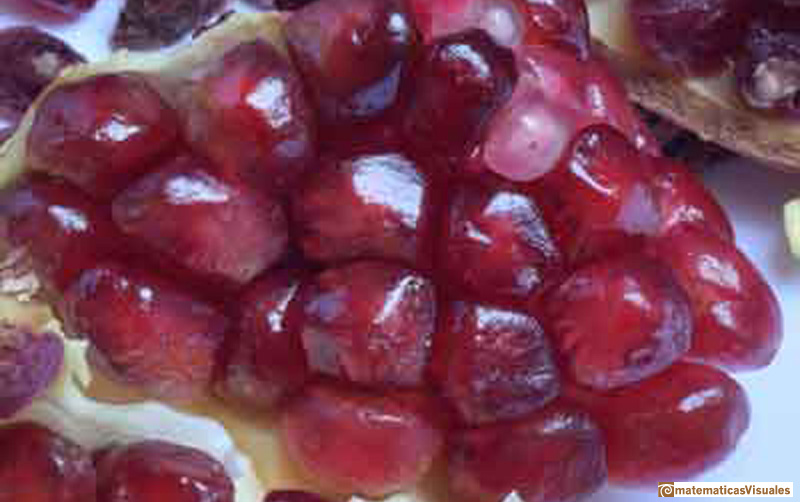
Figure 14. Pomegranate seeds with rhombic faces.
After pondering these examples inspired by nature, Kepler’s train of thought made what seems to be a radical change. He next took up the discussion of a popular technical problem of the time period: what is the best way to pile up cannonballs?
Kepler may have become interested in the question of the stacking of spheres through Thomas Harriot (ca 1560–1621). Harriot was an English mathematician, astronomer, and a friend and adviser to Sir Walter Raleigh (ca 1552–1618). Raleigh asked Harriot to solve several problems about the stacking of cannonballs because, as a sea explorer, he needed to deal with the issue on a practical level. Harriot solved these problems and went further by considering their connection with the then-new atomic theory of matter. Today, Harriot is considered one of the greatest mathematicians of his time. The range of his interests was wide and included mathematics (where he made important contributions to algebra), optics, and astronomy (where he built telescopes in order to make his own observations).
It is not known whether Harriot shared the problem of the best way to pack cannonballs with Kepler. We do know that they exchanged a few letters, with optics as the main subject of their correspondence. It was also very common in those days to circulate letters among friends and colleagues, and Kepler corresponded with many people.
However it may have come to his attention, Kepler became interested in the problem of stacking spheres and wrote about it in De Nive Sexangula. But how did Kepler link honeycombs and the seeds of pomegranates with this technical problem? As we are about to see, he did this by cleverly turning stacked cannonballs into rhombic dodecahedra.
Figure 15. A stack of cannonballs.
To begin, Kepler wrote:
In general, spheres of equal size will arrange themselves in one of two ways when placed in a container, corresponding to the two ways in which they can be arranged on a plane.
For if you take a number of spheres of equal size scattered over a horizontal plane and gather them into a small space so that they touch one another, they will come together either in a triangular or in a square arrangement. In the first case, each is surrounded by six others; in the latter, by four; and the pattern of contact is everywhere the same, except for the spheres on the edges. A pentagonal arrangement fails to produce a uniform distribution, while a hexagonal arrangement can be resolved into triangles. Thus, only the two aforementioned arrangements are possible [Kepler 1611, 55].
To make sense of this idea, we can start with a triangular or square arrangement of cannonballs and put more layers of spheres in the holes, like a grocer organizing oranges. Kepler himself noticed three things about such arrangements:
- These two apparently different arrangements (triangular or square base) are, in fact, equivalent. In both cases each sphere is surrounded by twelve others. Kepler explained this by writing:
There can be no triangular ordering without the square and vice versa [Kepler 1611, 59].
This is not immediately obvious, but the following video offers a good visual explanation:
There can be no triangular ordering without the square and vice versa.
Filmed in the workshop of the ceramist Luis Larriba in Tartanedo (Guadalajara, Spain).
- This is the tightest possible solid arrangement of spheres; that is, it wastes the least amount of space. This claim became known as the Kepler Conjecture. Despite the intuitive appeal of this simple conjecture, it took mathematicians nearly 400 years to formally prove it is correct. Many tried, and it was considered important enough that the influential mathematician David Hilbert (1862–1943) included it in his famous list of the 23 most significant problems that mathematicians should try to solve in the 20th century in order to advance the development of mathematics. Kepler’s Conjecture was finally proved by Thomas Hales and his graduate student Samuel Ferguson in 1998 with the help of computers; even then, the proof was so complicated that it wasn’t fully checked and published until 2005.
- When compressed, the spheres become rhombic.
Kepler’s third observation may seem the most unexpected; after all, only a very creative mind could have thought about squeezing iron balls! But was Kepler right?
To squeeze iron cannonballs is difficult, but we can try the same experiment using clay balls. We need thirteen such balls, which we will put into the following arrangement (with the bottom layer of three balls rotated so that it does not align exactly with the top layer) and then we will squeeze them carefully . . .
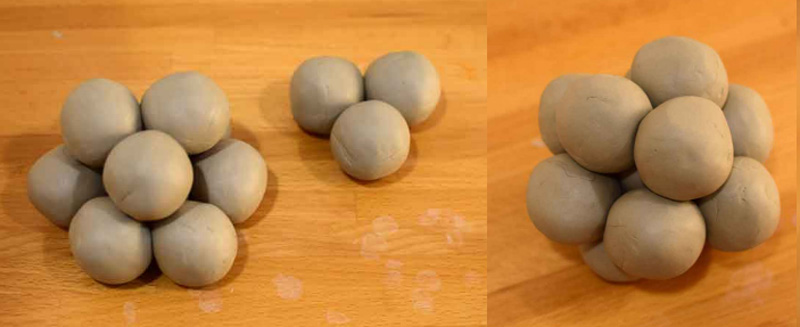
Figure 16. Preparation for the experiment of compressing spheres.
Compressing the spheres.
. . . and we get a rhombic dodecahedron. Easy and surprising!
Figure 17. The central sphere after squeezing: a rhombic dodecahedron.
If we imagine that we squeeze hundreds of balls in this way, we can see that we will get a lot of rhombic dodecahedra. We then conclude again that the rhombic dodecahedron tessellates space.
This was the incredible connection that Kepler found between how bees build their cells, how the seeds of pomegranates grow, and how best to pile up cannonballs. He was inspired first by nature and then by a technical problem—and he was able to blend these two perspectives wonderfully.
While Kepler’s idea of squeezing cannonballs is fresh in our minds, this is a good moment to go back to honeycombs in order to look for a plausible physical explanation of how bees build their cells. D’Arcy Thompson touched on this in his book On Growth And Form:
The most famous of all hexagonal conformations, and one of the most beautiful, is the bee’s cell. As in the basalt or the coral, we have to deal with an assemblage of co-equal cylinders, of circular section, compressed into regular hexagonal prisms; but in this case we have two layers of such cylinders or prisms, one facing one way and one the other, and a new problem arises in connection with their inner ends. We may suppose the original cylinders to have spherical ends, which is their normal and symmetrical way of terminating; then, for closest packing, it is obvious that the end of any one cylinder in the one layer will touch, and fit in between, the ends of three cylinders in the other. It is just as when we pile round-shot in a heap; we begin with three, a fourth fits into its nest between the three others, and the four form a “tetrad,” or regular tetragonal arrangement.
Just as it was obvious, then, that by mutual pressure from the sides of six adjacent cells any one cell would be squeezed into a hexagonal prism, so is it also obvious that, by mutual pressure against the ends of three opposite neighbours, the end of each and every cell will be compressed into a trihedral pyramid [Thompson 1942, 525].
We will next see how stacked spheres lead us to two other polyhedra before turning to Kepler’s third approach to the rhombic dodecahedron.
Kepler and the Rhombic Dodecahedron: The Cuboctahedron and Trapezo-rhombic Dodecahedron
Following our experiment with clay balls, we are in a position to talk about two other beautiful polyhedra.
Kepler was very interested in polyhedra in general, and in Archimedean solids in particular. In his Harmonices Mundi [The Harmony of the World, 1619], he systematically studied the Archimedean solids and made several new discoveries in that field.
Archimedean solids are named after the great Greek mathematician and physicist Archimedes, who Pappus (in Book V of his Mathematical Collection) reported was the first to give a description of them. But anything Archimedes himself wrote on this topic was lost long before Kepler’s time. This means that Kepler’s Harmonices Mundi is the oldest surviving detailed mathematical account of the Archimedean solids that is known today. It is interesting to note that Kepler referred to the Archimedean solids as “perfect in a lesser (or inferior) degree."[4] In contrast, he considered the Platonic solids (such as the cube) as belonging to the class of what he called the “most perfect“ solids due to their symmetry and regularity: every face of a Platonic solid is the same regular polygon and all of its angles are equal.[5] An Archimedean solid is not quite as symmetric or regular as a Platonic solid, but nearly so: the faces of an Archimedean solid always include two or more different types of regular polygons and its angles are not equal but do follow a uniform pattern.[6]
One of the 13 Archimedean solids identified by Kepler in his Harmonices Mundi is called the cuboctahedron. This beautiful polyhedron was known since prehistoric times and used in jewelry and decoration. It has a close relation with the rhombic dodecahedron and our experiment with balls.
If we put twelve balls surrounding a center ball as before, we can see that these twelve balls are in a regular disposition. They can be thought of as lying in the vertices of a cuboctahedron, as shown in Figure 18.
Figure 18. Spheres and cuboctahedron. The cuboctahedron is an Archimedean solid. Notice that any group of four adjacent faces that is formed by two squares interspersed with two triangles (such as the group we see in the top view) forms a regular hexagon.
The cuboctahedron has 8 equilateral triangles and 6 squares as its 14 faces. In comparison, recall that the rhombic dodecahedron has 14 vertices. This is not a coincidence! The twelve vertices of the cuboctahedron also correspond with the twelve faces of the rhombic dodecahedron. This kind of relationship, where the faces of one polyhedron can be matched to the vertices of another polyhedron, is called duality. The image in Figure 19 helps us see the correspondence that makes the cuboctahedron the dual of the rhombic dodecahedron (and vice versa).
Among other interesting properties, the cuboctahedron has 24 equal edges that are distributed in four “hexagonal sections,” each of which consists of three regular hexagons of the kind described in the caption of Figure 18. Do you remember the four belts of six rhombi of the rhombic dodecahedron? Each of those four belts corresponds with one of the four hexagonal sections of the cuboctahedron.
Figure 19. A cuboctahedron inside a rhombic dodecahedron, illustrating their dual relationship. Notice how each vertex of the rhombic dodecahedron corresponds to a face of the cuboctahedron and vice versa. Each of the rhombic dodecahedron’s four belts also corresponds to one of the cuboctahedron’s hexagonal sections. Cardboard and plastic. Vertices were produced using 3D printing.
To learn more about this fascinating polyhedron, building a physical model is again highly recommended. As before, one can do this by using a net such as the one provided (free for non-commercial use) on Gijs Korthals Altes’s splendid website Paper Models of Polyhedra. Another nice approach is to build a model using two different colors, one for the squares and another for the triangles, using a technique suggested by Magnus Wenninger in his classic book Polyhedron Models [1971]. Downloadable templates for printing the planar figures needed to build a two-color model of the cuboctahedron and other polyhedra are available on the author's matematicasVisuales website. Yet another interesting model of the cuboctahedron can be built using templates that first appeared in a Life Magazine article from March 1, 1943, about Buckminster Fuller’s Dymaxion World, also known as the Fuller Map Projection. Templates for constructing a model of Fuller's Dymaxion World can be downloaded from the blog site An Ocean Of Knowledge An Inch Deep.
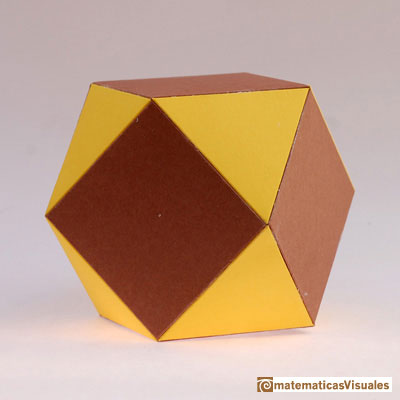
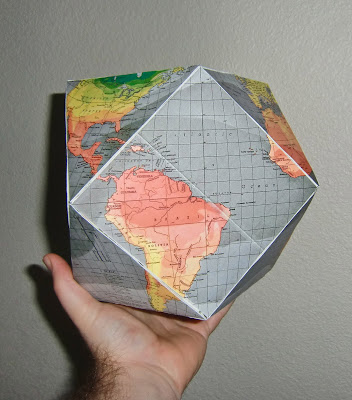
Figure 20. Two models of the cuboctahedron. (Left) A two-color model using the author's templates (matematicasVisuales). (Right) Buckminster Fuller's Dymaxion World, constructed by Cory Poole (An Ocean Of Knowledge An Inch Deep).
We can also get a cuboctahedron by cutting the vertices of a cube or an octahedron. This process is called ‘truncation’. The link given in the investigation “Properties of the cuboctahedron” below illustrates how this works.
|
TO INVESTIGATE Properties of the cuboctahedron. A cuboctahedron is an Archimedean solid. It can be visualized as made by cutting off the corners of a cube. We study some of its properties. This beautiful polyhedron is used as a decoration in art and jewelry. |
Applying Kepler’s compression idea with a slight twist gives us yet another polyhedron to admire. If we play with the stack of clay balls from our earlier experiment, we will easily realize that there is a second way to put twelve of those balls around the thirteenth; namely, with the bottom layer aligned exactly below the top layer, as illustrated in the right-hand image of Figure 21.
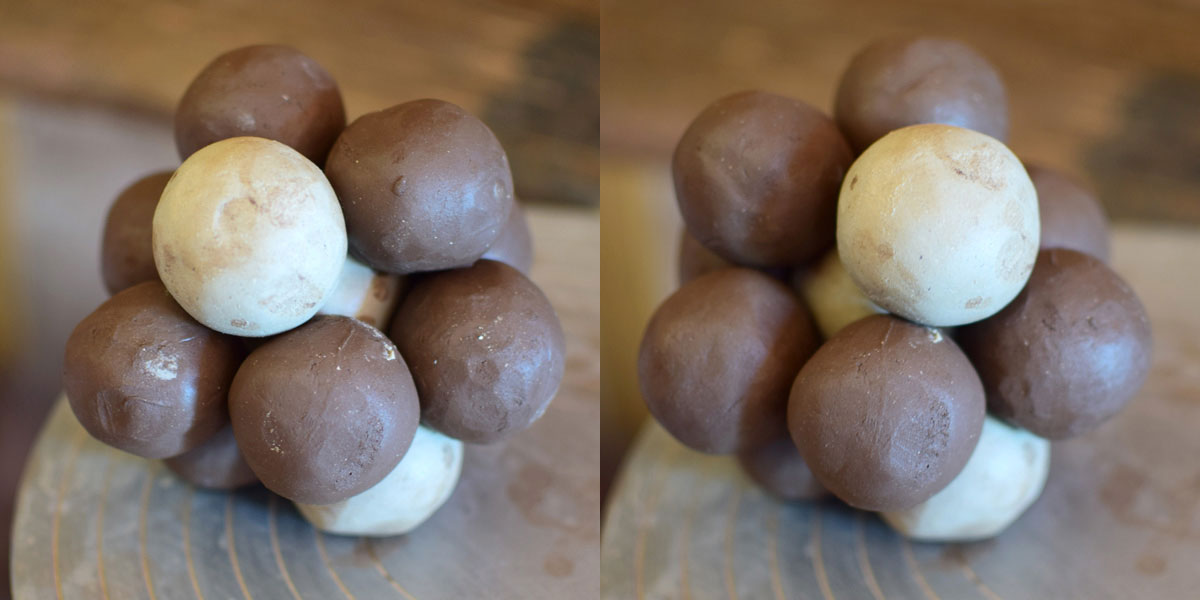
Figure 21. Notice the difference in alignment of the top layer and the bottom layer.
By squeezing this second structure, we will get a different polyhedron that is called a trapezo-rhombic dodecahedron since half of its twelve faces are rhombi and the other half are trapezoids. You can explore some of the properties of the trapezo-rhombic dodecahedron and a related polyhedron called the “twisted cuboctahedron” in the investigation "The trapezo-rhombic dodecahedron" below.
Figure 22. Trapezo-rhombic dodecahedron. Cardboard and magnets.
|
TO INVESTIGATE The trapezo-rhombic dodecahedron. The trapezo-rhombic dodecahedron is a polyhedron that also tessellates space. It has twelve faces, but six of them are trapezoids |
[4] Kepler defined the term “perfect to a lesser degree” for solids in Harmonices Mundi, Book II, Definition IX. In Proposition XVIII of that same book, he proved that there are 13 such solids and noted that these are precisely the 13 Archimedean solids. Kepler would most likely have learned about Archimedes’ enumeration of these solids by reading a Latin edition of Pappus’ Mathematical Collection that was published in 1588, as part of the Renaissance rediscovery of Greek mathematical masterpieces [Kepler 1619, 188].
[5] More specifically, Kepler referred to the five Platonic solids as the “most perfect regular” solids. His definitions of the terms “most perfect” and “regular” for solids are found in Harmonices Mundi, Book II, Definitions VI & VII; his proof that there are 5 such solids is given in Proposition XXXV of that same book.
[6] This description of what happens with the angles of an Archimedean solid is intentionally stated in somewhat vague terms. This is done in part because there are currently two different definitions for this type of solid that give a different number of Archimedean solids (either 13 or 14) depending on which one is used. (See, for example, [RobertLovesPi 2014]). For the purpose of the activities proposed in this article, however, this technical issue is not of direct relevance. As noted above, Kepler himself identified 13 Archimedean solids in his Harmonicas Mundi. Interestingly, he stated elsewhere that there are 14 such solids; footnote 7 gives some additional details about this.
Kepler and the Rhombic Dodecahedron: Renaissance Artists – They Almost Got It!
To set the stage for our presentation of a third view of the rhombic dodecahedron that Kepler taught us, this is a good opportunity to look at why Renaissance artists were interested in polyhedra and how they almost discovered the rhombic dodecahedron as a result of that interest.
During the Renaissance, sound translations of the classics were widely available. Artists, scientists and craftsmen were interested in mathematics and, in particular, in polyhedra. They found them to be beautiful objects for depiction in their artwork as well as good examples for the practice of the new technique of linear perspective.
Albrecht Dürer (1471–1528) was the first to publish nets of polyhedra. Nowadays we are used to using nets to build polyhedra, but Dürer was a pioneer in using a flat two-dimensional format as a means to provide information about a three-dimensional body. For example, the following drawing is the net of a cuboctahedron that he published in his book Underweysung der Messung [Dürer 1525].
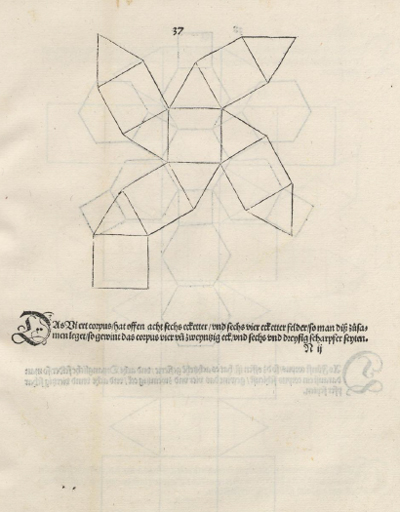
Figure 23. Dürer’s net of a cuboctahedron.
Renaissance artists also knew how to generate new polyhedra through the process of truncation by cutting the vertices of other polyhedra. Leonardo da Vinci, for instance, drew beautiful images of polyhedra for Luca Pacioli's book De Divina Proportione [1509].
Video inspired by Leonardo's depiction of a cuboctahedron.
Yet another procedure that Renaissance artists used to create new polyhedra was the placement of equilateral pyramids on top of the faces of a given polyhedron. Pacioli called this kind of new polyhedra ‘elevatus.’ We can use the words ‘augmented’ or ‘raised’ to capture this meaning. For example, if we augment the faces of a cube with six pyramids, we get a raised polyhedron that has 24 triangular faces.
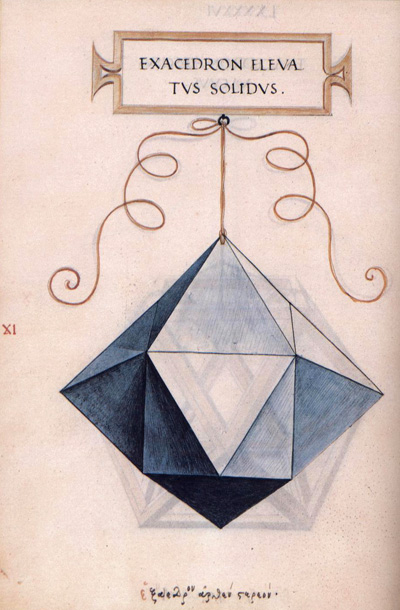
Figure 24. A Spanish translation of Pacioli's book, La Divina Proporción.
With permission of Editorial Akal.
The polyhedron shown in Figure 24 is very close to being our rhombic dodecahedron. Renaissance artists almost got it: our polyhedron is virtually there, in front of their eyes, as were actual garnets. But credit for the discovery of a new rhombic polyhedron belongs to Kepler.
What did Kepler do differently that allowed him to see what his artistic predecessors did not? Perhaps the most relevant difference between the approach of the Renaissance artists and that of Kepler is that the former usually augmented a polyhedron with equilateral pyramids, whereas Kepler was looking for some regularity in the resulting polyhedron, rather than in the pyramids used to produce it. As a mathematician, he was also more systematic in his study of polyhedra and his investigation of their regularity. For example, before Kepler only some Archimedean solids had been described, but it was Kepler who rediscovered the complete set of thirteen such solids that Archimedes was reported to have identified.
|
|
More about Leonardo da Vinci’s drawings of polyhedra for Luca Pacioli's book De divina proportione, with video animations. |
|
Leonardo da Vinci: Drawing of a cuboctahedron made for Luca Pacioli's De divina proportione.
|
|
Kepler and the Rhombic Dodecahedron: The Rhombic Dodecahedron as a Cube with Pyramids
We have now seen two of the different approaches that Kepler used to study the rhombic dodecahedron.
First, he identified this polyhedron by looking at how bees build their cells. He was inspired by nature.
Second, he found the rhombic dodecahedron as a result of squeezing cannonballs. This study was related to a technical problem.
Both these points of view are wonderful examples of what Kepler's creative mind was able to accomplish. But if we want to gain a deeper mathematical understanding of the rhombic dodecahedron—for example, by finding the length of the two diagonals of its rhombi, its volume, or the measure of its angles—another approach would be helpful. And it was Kepler, once again, who gave us a way to see the rhombic dodecahedron that not only makes it simpler to do these basic calculations, but also gives yet another beautiful explanation of why this polyhedron tessellate space.
The key to this third point of view was that Kepler understood that the rhombic dodecahedron can be seen as an 'elevatus' cube: a cube with six special pyramids attached.
In his book Epitome Astronomiae Copernicanae [Kepler 1618–1621], Kepler wrote about the rhombic dodecahedron once more and drew the following clarifying picture:

Figure 25. Kepler, Epitome Astronomiae Copernicanae [1618–1621, 460]. A cube with augmented pyramids.
In the following video, we can see how changing the height of the pyramids attached to a cube results in different polyhedra with 24 triangular faces. But, when those pyramids reach a certain precise height, pairs of neighboring triangular faces lie in the same plane and become rhombi.
Animation of cube augmented with pyramids of different heights.
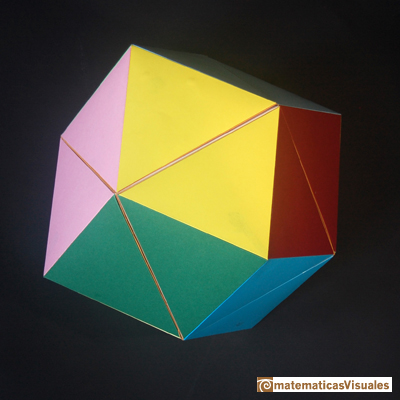
Figure 26. A cube with augmented pyramids. Cardboard and magnets.
What consequences can we derive from this approach to viewing the rhombic dodecahedron? Here, we outline the ideas behind four basic properties of this polyhedron and provide links to investigations that explore two others.
1) First, we can inscribe a cube inside a rhombic dodecahedron.
Figure 27. A rhombic dodecahedra with an inscribed cube (at left) and an inscribed octahedron (at right); the rhombic dodecahedra are shown in red and the inscribed polyhedra in blue.
Notice that the cube is produced by linking the eight vertices of the rhombic dodecahedron. Can you see which polyhedron we get when we link the six vertices where four edges of the rhombic dodecahedron meet? (The answer to this question is revealed in Figure 27 and discussed further below.)
2) Second, we can calculate some basic measurements; namely, the lengths of the diagonals of each face and the length of the polyhedron’s edges.
To do this, we need the precise height h of the raised pyramid that gives us the rhombic dodecahedron; this is not very difficult to calculate. To see the details of the computations and learn the values of these lengths, click here.
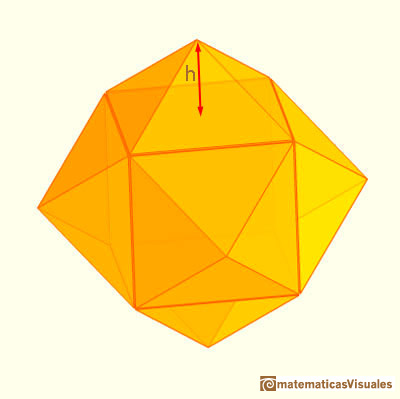
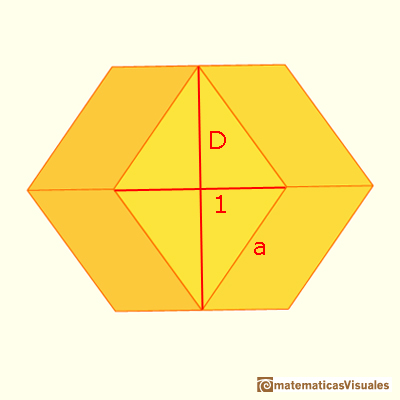
3) There is a basic relation between the volume of the rhombic dodecahedron and the volume of the inscribed cube. Namely, the volume of the rhombic dodecahedron is double the volume of the inscribed cube.
To see this, notice that the six pyramids that we attach to the cube in order to create the rhombic dodecahedron can instead be put inside that cube with their vertices joined at the center of the cube. The following video illustrates one approach to visualizing this relationship:
Turning a rhombic dodecahedron inside-out..
It is not difficult to build a model of the construction in this last video by using cardboard (with magnets inside), as shown in Figure 28.
Figure 28. A cube with pyramids attached, with a section of the cube outlined in red. Note that the pyramids can be turned either to the outside of the cube (to give a rhombic dodecahedron) or placed on the cube’s inside. Cardboard and magnets.
We can use this “double” relationship between the volume of the rhombic dodecahedron and the volume of the inscribed cube to write the volume of a rhombic dodecahedron as a function of its edge length. To see the details of this computation, click here.
4) We can tessellate space with rhombic dodecahedra.
Hugo Steinhaus described this property in a simple and precise way:
We have already mentioned filling the whole of space with cubes. We can get another filling of this sort by the following procedure: we make the cubes alternately black and white to get a kind of chessboard and then we remove the black ones. We decompose each void space into 6 pyramids on square bases with a common vertex in the center of the void space. If we consider a single white cube with 6 pyramids based on it, we see a rhombi dodecahedron with a cube inscribed in it; it is obvious that by our procedure we have filled the whole of space with congruent rhombic dodecahedra. . . . The vertices are of two kinds: (1) where 4 solids meet; (2) where 6 solids meet [Steinhaus 1983, 185–186].
Tessellating space with the rhombic dodecahedron.
Kepler was well aware of this property. For example, he wrote in his book De Nive Sexangula:
[The rhombic dodecahedron] shares this property with the cube: that just as eight corners of eight cubes brought together at a single point will fill the space entirely and leave no gap, so will the corners of the first kind of rhombic figure, when four of the obtuse (trilateral) angles or six of the quadrilateral angles come together. Thus, a space can be completely filled just with rhombic figures of this kind, as long as four three-sided angles or six four-sided angles always come together at a single point, so that a solid whole is made. . . .
This, then, is the geometric figure closest to a regular solid that fills a space entirely, just as the hexagon, the square, and the triangle fill a plane. It is the very shape that bees produce in their honeycombs, except for the fact that their cells lack a roof to match the bottom [Kepler 1611, 45].
|
|
TO INVESTIGATE Density of the optimal sphere packing. Using what we now know about the volume of the rhombic dodecahedron and its space-tessellation property, we can also calculate the density of the optimal sphere packing, using the rhombic dodecahedron as a unit cell. |
Kepler and the Rhombic Dodecahedron: The Rhombic Dodecahedron as a Cube with Pyramids – Some Basic Measurements
As was noted on the previous page, by viewing the rhombic dodecahedon as a cube augmented by pyramids, we can easily calculate some basic measurements; namely, the lengths of the diagonals of each face and the length of the polyhedron’s edges.
To do this, we need the precise height h of the raised pyramid that gives us the rhombic dodecahedron.
For simplicity, we can assume that the length of the cube’s edge is 1. The “trick” is then to slice through the three-dimensional object (shown at left below) to get a two-dimensional cross section (shown at right below). Elementary plane geometry and the Pythagorean Theorem let us calculate the value of h. Once you have found that value, click on the button below the cross-sectional image to see if you are correct.
 |
|
Looking again at the two images above, can you see how the side of the outer square of the cross section is the longer of the two diagonals of the rhombi that form the faces of our polyhedron? We can now calculate the length of the side of that outer square, which we label D in the next image. (The answer is once more hidden under the button):
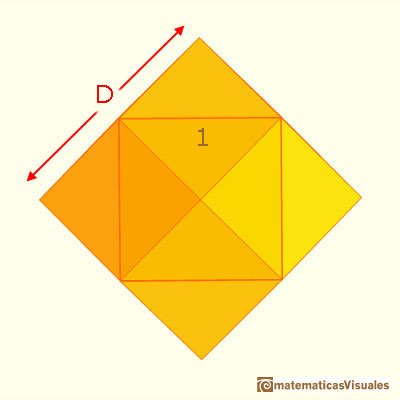 |
As previously mentioned, our rhombi have two diagonals; the measure of the longer one is D . . .
. . . and the measure of the shorter one is 1 (by our initial assumption).
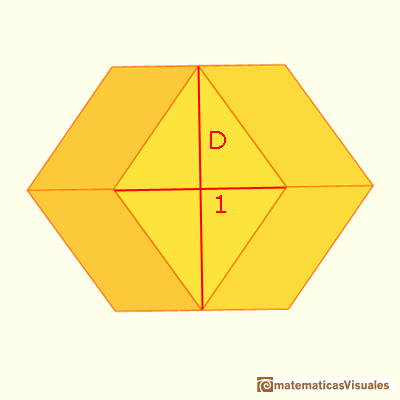
We can now use these values to calculate the side length of the rhombi, labeled a in the next diagram; this calculation also gives us the length of the polyhedron’s edges.
 |
And what if our initial cube doesn’t have unit length? Simply scale all the answers above by multiplying by the actual length of the cube’s edge! If you also know some basic trigonometry, you can find out about the angle measures with the following investigation.
|
|
TO INVESTIGATE Angles of the rhombic faces of a rhombic dodecahedron. We need some basic trigonometry to calculate angles of the faces of the rhombic dodecahedron. The obtuse angle is called a Maraldi Angle. It was named after Giacomo Maraldi (1665–1729), the first mathematician to study and publish about the angles of the rhombi at the bottom of bee cells. |
Kepler and the Rhombic Dodecahedron: The Rhombic Dodecahedron as a Cube with Pyramids – Volume as a Function of Edge Length
As we saw on a previous page, the volume of the rhombic dodecahedron is double the volume of the inscribed cube.
We now use this “double” relationship between the volume of the rhombic dodecahedron and the volume of the inscribed cube to write the volume of a rhombic dodecahedron as a function of its edge length.
First, recall (from our earlier computations) that if we start with a cube with side length 1, then each edge length of the rhombic dodecahedron is \(\frac{\sqrt{3}}{2}\). This lets us write the volume of this particular rhombic dodecahedron as a function of its edge length:
 |
|
Now, let’s scale this formula to get the volume of a rhombic dodecahedron that has edge length 1.
 |
|
 |
|
Finally, we scale once more to get the volume formula for a rhombic dodecahedron with arbitrary edge length a.
 |
|
Return to list of properties of the rhombic dodecahedron.
Kepler and the Rhombic Dodecahedron: Building a Cube and an Octahedron Inside a Rhombic Dodecahedron
As previously suggested, the best way to understand three-dimensional bodies is to make physical models. As a complement to our construction of a rhombic dodecahedron, we close by building a few other related polyhedra.
We already know that we can put a cube inside a rhombic dodecahedron. The vertices of this cube are the vertices of the rhombic dodecahedron that join three rhombi.
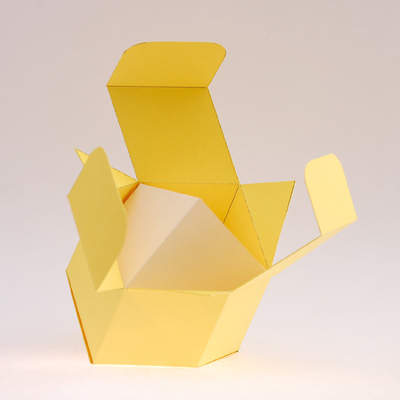
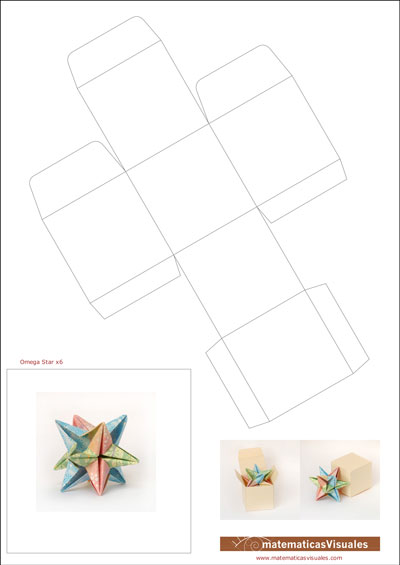
Figure 29. A cube inside a rhombic dodecahedron and its corresponding net.
(Note that the net is scaled to produce a model that fits inside the rhombic dodecahedron constructed earlier.)
As shown in the template given in Figure 29, we can also put a beautiful piece of origami, an omega star, inside our cube. The omega star has the structure of a cuboctahedron. It is both easy and a real pleasure to fold this example of “modular origami” using six pieces of paper. Highly recommended! The square in the lower left-hand corner of the template is correctly sized for building an origami star that fits inside the cube. (For instructions on how to build the star itself, see, for example, this YouTube video by Philip Shen.) With a bit of imagination, we can see from Figure 30 that the twelve vertices of the omega star (cuboctahedron) are located at the centers of the rhombic faces of the rhombic dodecahedron.
Figure 30. A rhombic dodecahedron, a cube, and an omega star (cuboctahedron).
Finally, as suggested in Figure 27, the six vertices of the rhombic dodecahedron at which four rhombi meet are also the vertices of an inscribed octahedron. The net given in Figure 31 below is again scaled perfectly to construct an octahedron that fits inside the rhombic dodecahedron that you constructed earlier.
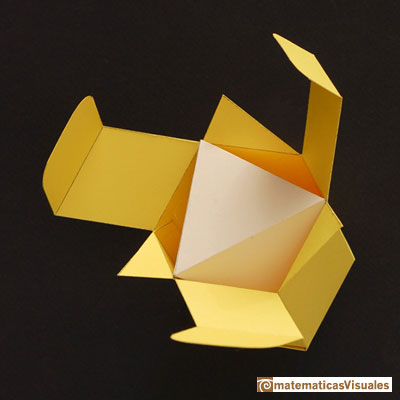
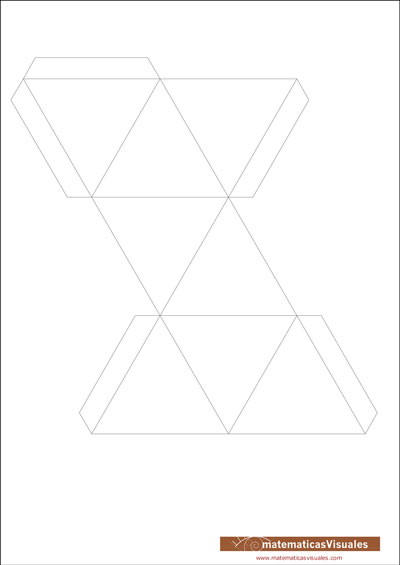
Figure 31. An octahedron inside a rhombic dodecahedron and its corresponding net.
(Again, the net is scaled to to produce a model that fits inside the rhombic dodecahedron constructed earlier.)
Kepler and the Rhombic Dodecahedron: Conclusion – Kepler’s Other Rhombic Polyhedron Discovery
Kepler’s discovery of the rhombic dodecahedron by observing the base of bee cells marked the wonderful birth of a new polyhedron. He then showed that this rhombic dodecahedron was related to a technical problem: how best to pile up cannonballs. Next, he taught us perhaps the simplest way to understand the rhombic dodecahedron, as a cube augmented with pyramids. He also knew that the rhombic dodecahedron, like the cube, can be used to tessellate space.
Was his mind at rest following these discoveries? No, not at all.
Kepler wrote:
Intrigued by these rhombi [the rhombi from the bottom of bee cells], I began looking into geometry to see whether a body resembling the five regular solids and the fourteen]7] Archimedean solids could be constructed exclusively from rhombi. I discovered two, one related to the cube and the octahedron, the other to the dodecahedron and the icosahedron. (The cube itself can be considered a third, since it is like two tetrahedra joined together.) The first of these solids is contained by twelve rhombi, the other by thirty [Kepler 1611, 43 and 45].
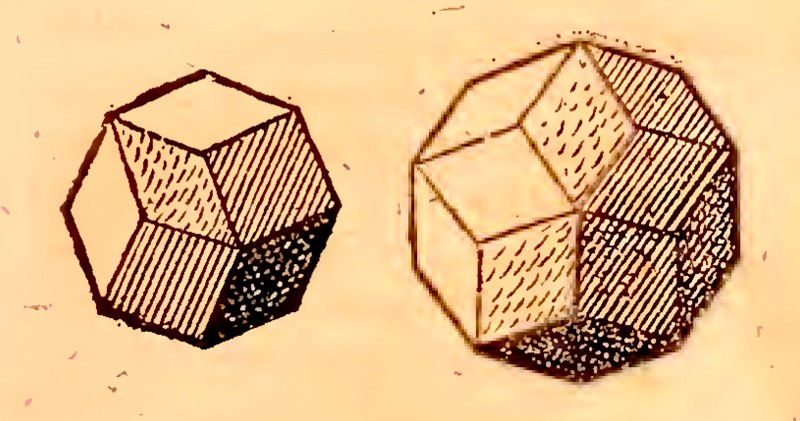
Figure 32. Drawings of a rhombic dodecahedron and a rhombic triacontahedron, from Harmonices Mundi Book II, p. 61.
The second rhombic polyhedron that Kepler discovered, with thirty faces, is called the triacontahedron.
Figure 33. Three rhombic polyhedra: rhombic dodecahedron, triacontahedron, and cube (3d-printed models).
How did Kepler discover the triacontahedron after identifying the rhombic dodecahedron?
What are the relations between these two rhombic polyhedra?
Is the cube a third rhombic polyhedron only because its six faces are square, that is to say, a special kind of rhombus? Or is there a deeper connection between these three rhombic polyhedra?
The study of the triacontahedron and the answers to these questions deserve another article!
[7] It is interesting that Kepler wrote "Archimedeis quattuordecim" (which translates as "the fourteen Archimedean solids") here. As previously noted, he later showed that there are only thirteen such solids that satisfy the definition he gave in Harmonices Mundi. Although we don’t know why Kepler gave the number of Archimedean solids as 14 in his earlier work, it is possible that he was thinking of the pseudo-rhombicuboctahedron—this is the fourteenth polyhedron that distinguishes the two different definitions of Archimedean solids in use today (mentioned in footnote 6). As far as is known, Kepler never publicly reconciled his earlier statement in De Nive Sexangula with his later detailed enumeration in Harmonices Mundi.
Kepler and the Rhombic Dodecahedron: Investigation Links
|
TO INVESTIGATE Kepler: The Volume of a Wine Barrel. To learn more about Kepler’s contribution to the development of calculus, read this article published in Convergence in 2011. |
|
TO INVESTIGATE A property of minima in honeycombs. Using derivatives, we can solve an isoperimetric problem that interested 18th-century mathematicians such as Colin Maclaurin (1698–1708): We want to close a hexagonal prism as bees do, using three congruent rhombi. What is the shape of the three such rhombi with minimum total surface area? |
|
TO INVESTIGATE Properties of the cuboctahedron. A cuboctahedron is an Archimedean solid. It can be visualized as made by cutting off the corners of a cube. We study some of its properties. This beautiful polyhedron is used as a decoration in art and jewelry. |
|
TO INVESTIGATE The trapezo-rhombic dodecahedron. The trapezo-rhombic dodecahedron is a polyhedron that also tessellates space. It has twelve faces, but six of them are trapezoids |
|
|
More about Leonardo da Vinci’s drawings of polyhedra for Luca Pacioli's book De divina proportione, with video animations. |
|
Leonardo da Vinci: Drawing of a cuboctahedron made for Luca Pacioli's De divina proportione.
|
|
|
|
TO INVESTIGATE Angles of the rhombic faces of a rhombic dodecahedron. We need some basic trigonometry to calculate angles of the faces of the rhombic dodecahedron. The obtuse angle is called a Maraldi Angle. It was named after Giacomo Maraldi (1665–1729), the first mathematician to study and publish about the angles of the rhombi at the bottom of bee cells. |
|
|
TO INVESTIGATE Density of the optimal sphere packing. Using what we now know about the volume of the rhombic dodecahedron and its space-tessellation property, we can also calculate the density of the optimal sphere packing, using the rhombic dodecahedron as a unit cell. |
Space holder.
Kepler and the Rhombic Dodecahedron: References
Cardil, Roberto. 2007–2022. matematicasVisuales.
Caspar, Max. 1993. Kepler. New York: Dover Publications, Inc.
Coxeter, H.S.M. 1961. The Five Platonic Solids. In Introduction to Geometry, 148–160. John Wiley and Sons, Inc.
Cromwell, Peter R. 1997. Polyhedra. Cambridge: Cambridge University Press.
Cundy, H..Martin, and A. P. Rollet, 1961. Mathematical Models. 2nd ed. Oxford: Oxford University Press.
Dürer, Albrecht. 1525. Underweysung der Messung, mit dem Zirckel und Richtscheyt, in Linien, Ebenen und gantzen corporen. Nüremberg: Hieronymus Andreae.
Fejes Tóth, L. 1964, July. What the bees know and what they do not know. Bulletin of the American Mathematical Society 70(4): 468–481.
Heath, Thomas. 1921. A History of Greek Mathematics. Volume II: From Aristarchus to Diophantus. Oxford: Oxford University Press.
Field, J.V. 2013. Kepler's Geometrical Cosmology. Bloomsbury.
Hope-Jones, W. 1936, October. The Rhombic Dodecahedron for the Young. The Mathematical Gazette 20(240): 254–257.
Kepler, Johannes. 1611. Strena Seu De Nive Sexangula (The Six Cornered Snowflake: A New Year's Gift). English translation by Jacques Bromberg (with comments and notes by Owen Gingerich and Guillermo Bleichma). Philadephia: Paul Dry Books, 2010.
Kepler, Johannes. 1618–1621. Epitome astronomiae copernicanae, usitatâ formâ quaestionum & responsionum conscripta (Epitome of Copernican astronomy, written in the usual form of questions and answers). Linz: Johann Planck [vol. I]; Linz: Johann Planck for Gottfried Tambach [vol. II]; and Frankfurt: Gottfried Tambach [vol. III]. English translation of Books IV & V by Charles Glenn Wallis, Amherst, NY: Prometheus Books, 1995.
Kepler, Johannes. 1619. Harmonices Mundi (The Harmony of the World). English translation with an introduction and notes by E. J. Aiton, A .M. Duncan, and J. V. Field. Philadelphia: American Philosophical Society, 1997.
Maclaurin, Colin. 1743. On the Bases of the Cells wherein the Bees deposit their Honey. Philosophical Transactions 42: 709–713.
Pacioli, Luca. 1991. La divina proporción. 4th ed. Spanish translation by Juan Calatrava. Tres Cantos, Spain: Akal. Original published in 1509.
Pedoe, Dan. 1978. Geometry and the Liberal Arts. 2nd ed. New York: St. Martin's Press.
Poole, Cory. 2011, May 21. Dymaxion World: Cubeoctahedron Globe. An Ocean Of Knowledge An Inch Deep.
RobertLovesPi. 2014, June 10.The Archimedean Solid That Isn’t. Polyhedra, tessellations, and more.
Rouse Ball, W.W. 1947. Mathematical Recreations & Essays. 11th ed. London: The Macmillan Company.
Shen, Philip. 2015, April 1. 3d Origami Omega Stars Instructions. YouTube.
Steinhaus, Hugo. 1983. Mathematical Snapshots. 3rd ed. Oxford: Oxford University Press.
Szpiro, George G. 2003. Kepler's Conjecture. New York: John Wiley and Sons, Inc.
Thompson, D'Arcy. 1942. On Growth and Form. 2nd ed. 2 vol. Cambridge: Cambridge University Press.
Wenninger, Magnus. 1971. Polyhedron Models. New York and Cambridge: Cambridge University Press.
Kepler and the Rhombic Dodecahedron: Acknowledgements and About the Author
Acknowledgements
I would like to thank Amy Ackerberg-Hastings and Janet Heine Barnett, Convergence editors, for their support, encouragement, and good advice. Without their help this article would not have been published.
I thank the anonymous referees for suggestions that improved the article.
I am grateful to John Jeremiah Edminster for granting permission to use their designs of a rhombic box and a bee cell box and to Cory Poole for allowing use of his photo of Buckminster Fuller's Dymaxion World model. I am also grateful to Akal Editorial for granting permission for the use of images from Pacioli's book La Divina Proporción.
Miguel Cardil helped me with the artistic design of the pages.
About the Author
Roberto Cardil Ricol is a secondary school teacher of mathematics in Spain. He completed his teacher training at Huesca University, Spain, and holds Bachelor degrees in both History (Barcelona University, Spain) and Mathematics (Zaragoza University, Spain). He has taught mathematics to students ranging from 6 years old to the university level. He maintains the site www.matematicasvisuales.com and enjoys the beauty of mathematics.
